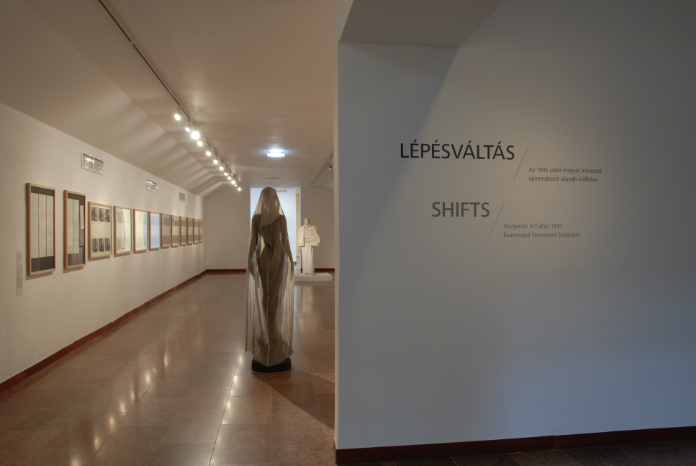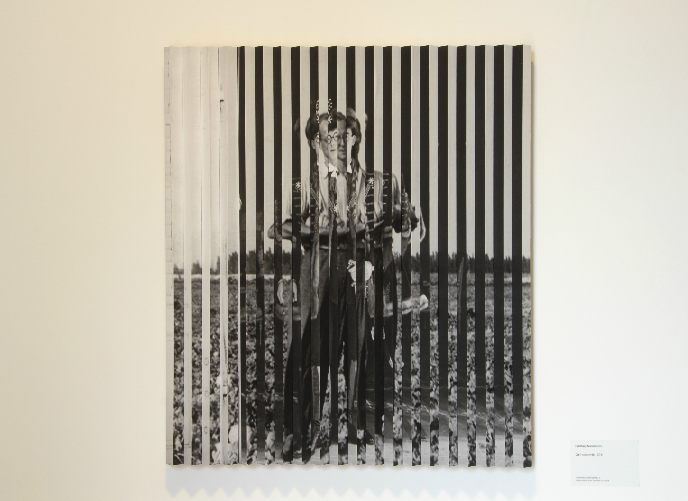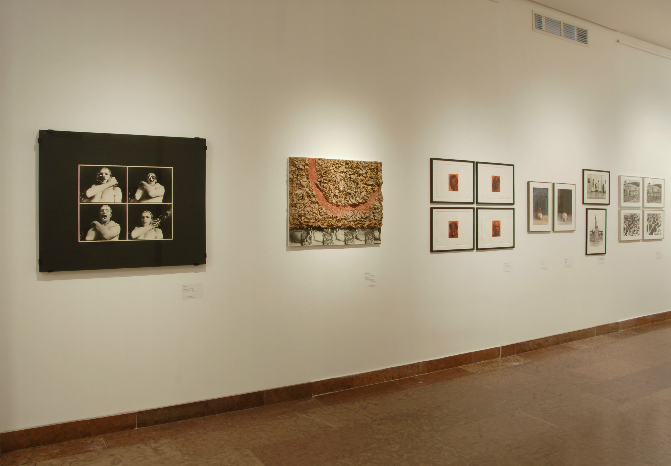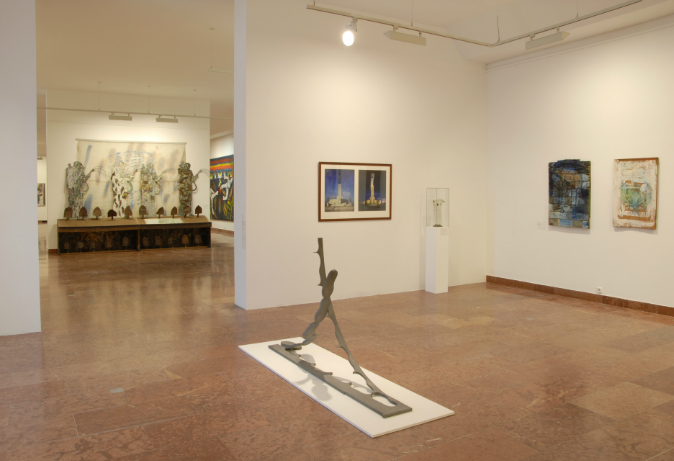Interview with Zsolt Petrányi, a curator of the National Gallery
SHIFTS
The exhibition Lépésváltás (Shifts) opened in The National Gallery in October, 2013. It displays a selection of works from the period following 1945. The curator tells us about the challenges of the project.
| Berényi Marianna |
2014-05-28 09:00 |
The contemporary collection comprises of more that 12.000 works of art. This exhibition was implemented in a space of 1500 square meters and you finally selected 150 pieces. How representative such an exhibition can be?
We were still working on the exhibition when doubts arose, for example, because the exhibition does not include a single work of media art from the past two decades, although video works, for that matter, surely seem indispensable. This dilemma highlighted two important issues: visitors expect an exhibition which offers a panoramic view of a period that spans over decades and, after getting that story, they finally want to know what is going on in contemporary art. However, I can only build on our collection. I can’t create a collection that is not in the possession of the National Gallery, although since 1990 this idea has been raised. The history of art has numerous fields and many of them are just not part of our collection, these works of art are not here, simply because when they were produced, collectors’ attention was focussed on something else. In such a case, the curator can ask the artist to bring in the missing items, but I finally concluded that I did not want to do that. I was commissioned to make an exhibition of the National Gallery’s contemporary collection and not of the art of the past decades in general. My task was to select and structure the 150 that can represent those 12.000.

Fair enough, but we all now that the missing works of art are there in the Ludwig Museum, on the other side of the river. How are these two exhibitions linked together?
The Ludwig Museum was my other source of frustration. When they started to collect in the 1990s, they, in fact, followed the line the National Gallery had set. Their exhibition Az égbolt másik fele. Válogatás a Ludwig Múzeum gyűjteményéből, (The other half of the sky. A selection of works from the collection of the Ludwig Museum) curated by Kriszta Szipőcs, includes several items whose pairs are in our collection. I didn’t want to compete, so I didn’t select them. On the other hand, I picture such visitors for myself who are interested in art, and if they want to learn about this period of the Hungarian fine art, they can go to three different places for a comprehensive view: the Kiscell Museum, the Ludwig Museum and the National Gallery.
How is the exhibition you curated different from the other two? What is the National Gallery supposed to display?
The biggest difference lies in the way the National Gallery structures the last 70 years. When I started preparing for this work, I realised that what I missed from the earlier exhibition here was this educational role. Often while I was guiding colleagues from Western-Europe in the old exhibition, I couldn’t help feeling that they would have faced serious difficulties in interpreting these works of art if they had been walking around in those rooms alone. I decided to divide the new exhibition into sections and I wanted to place these sections in the centre. In the Ludwig Museum exhibitions are rotating at a relatively high speed, and they are based on curatorial initiatives, but here, I’m afraid I can’t do that since it’s not 700, but 12.000 works of arts that serve as the basis for this exhibition. Actually, the collection of the National Gallery is the biggest from this period. It is an extremely wide selection, there are outstanding items as well as state purchases from the 1960s.
Can we represent a period by selecting and displaying only the best quality works of art from that period?
Certainly we can’t. In every period there are great achievements and pieces we re-interpret after some time. The re-arrangement of this exhibition facilitated precisely this: I could work with different works of art, knowing very well that the previous selection was on display for 12 years.

I have the feeling that in the first half of the exhibition you have a very clear view of the specific era or style you cover there, however, in the second half this structure seems to disappear, you do not direct the attention of the visitor, or you do it differently. You yourself referred to this at the press conference, saying that these borders started to dissolve in the 1990s.
That’s right. And this also feels from the texts on the walls, since their structure changes as we reach 1990 in the exhibition. I set the rule to myself to use sources contemporary to the works of art and to that specific section. That was very important for me since I saw that as the second educational layer of the exhibition. However, when I started to study the texts which were intended to take the comprehensive view of a period, I realized that they are essentially partial, due to the proximity of that period and also to the character of that era. It was extremely difficult to find a one-sentence-long statement which was a good summary and was also objective. My dilemma was: who should be the witness? Who can make a statement about this era? Could it be only one source? Since I have been an art historian since 1990 and has been curating exhibitions ever since, I simply decided to let this whole dilemma go and to form my own statements about this period.

Why do you think you could not find the proper witness?
Art history’s reference points had not yet crystallized at that time. I was very much interested in the book entitled Kulturális átöltözés: művészet a szocializmus romjain by Edit András, since I assumed that the most fundamental experience of the 1990s was the transition from socialism to capitalism. However, I noticed that András tends to be nostalgic about the 1980s: in her view, for example, international relations were more open and this disappeared in the 90s. For the exhibition that sort of negative attitude to the 90s could not serve as a guideline.
Then what can serve as a basis for our comprehensive view of the 1990s?
The fall of socialism had a fundamental impact on the way of thinking of the intelligentsia. The free flow of information, travelling and scholarship opportunities created new chances and the artistic quest took many directions. There were very decisive artistic phenomena in this period. Media art appeared, the Intermedia Department at the Academy of Fine Arts was established, and the use of computer became prevalent. There was a dialogue between the artists, painters and photographers who used computer platforms. However, if the Contemporary Collection did not focus on that at that time, it, very obviously, cannot reflect this discourse, and then this cannot be displayed. Nevertheless, certain works of art which drifted out of the art discourse have turned up recently and I was very keen to include them in the exhibition. For example, the painting of the early 1990s, when young painters started to stand up against „New sensibility”.

And what about the country-side? Were there significant artistic achievements?
Yes, there were. Although in Hungarian art life Budapest has always been a dominating centre, Pécs, Székesfehérvár, Szentendre, Szombathely, Paks or Mezőszemere have produced important artist too in the past couple of decades. Several of them are featured in this exhibition.
When considering an exhibition on such a scale like this, the question obviously arises: How can the National Gallery influence the artistic canon?
Well, it was not accidental that László Baán, the director of the Museum of Fine Arts, emphasized at the press conference that what is seen here is Zsolt Petrányi’s view. It’s going to be open for some years and then it will lose its validity. The Ludwig Museum, quite rightly, replaces its exhibitions in every one and an half – two years in order to allow different opinions and views form and be conveyed. If the previous exhibition here intended to represent the mainstream, and to a certain extent the less mainstream artists, as comprehensively as possible, then this exhibition has the ambition to offer a historical structure. And the next curator will have, most certainly, different aspirations. And surely the Ludwig Museum also plays an important role in shaping the canon.
It is an important part of the project that the works of art will continuously be replaced. Do you think the ones coming in later will be able to fit in the stories and the parallels?
We have to replace the paper based works for conservation reasons, but I could prepare for this in the case of the paintings. It is more difficult with the photos, because there is nothing to replace them with. For example, without four of Miklós Erdély’s works it would have been impossible to put this exhibition together. It was quite misleading in the previous exhibition that his oeuvre was represented by a single painting made in the 80s. What am I going to bring in after six months? I don’t know yet, but there surely has to be a work of Erdély in the exhibition. The point is that we must not put works of art on display which would change the narrative and the concept of the exhibition.

By the way, how did you build up the concept of this exhibition?
One of the three building blocks of the concept is outstanding achievement, another one is a confession: the history of Hungarian art is not made up of historical events building on one another neatly, but there are progressions and lines running parallel. The third element is that the exhibition is an art-historical manifesto. In this respect the National Gallery’s first exhibition in 1975 is very important: the curator, Gábor Pogány, also selected works from artists who were tolerated, but not appreciated or supported by the regime. I had to admit that there was no chance to change the interior itself, I could not remove the marble. Since I could not change the space I decided to use it as a reference point, which can speak about the approach on the basis of which the first exhibition was created. I do not only concentrate on the decisive points of a period defined by art history, but I also evoke certain moments of certain exhibitions.
The rotunda became part of the exhibition too.
Yes, and not only the rotunda, but the staircase in front of it also functions as a kind of lead-in. Although I have no means to influence the visitors whether they come up on the stairs or in the elevator, I lead them with two topical blocks into the exhibition. The space at the lower level is clearer: it was easy to fill it with the works of Szalai, Jovánovics, Megyik és Kondor. The rotunda, however, proved very challenging, since a Dózsa-statue has been there for decades, although it is owned by the National Museum. I chose to give a contrast to it. Now the entrance is kind of guarded by a large-size installation by El-Kazovszkij: visitors coming up on the stairs encounter this installation first and not the Dózsa-statue. It’s also important to mention here that the exhibition had a working title: From the atelier to the exhibition hall. The exhibition also wanted to talk about how works make their way to the museum. It’s not only through purchases, but also as deposits or gifts. And indeed in the rotunda there are two works on deposit: those of Szervátius and El Kazovszkij.
You mentioned that you had imagined a new type of visitor. What is your visitor like?
I teach art management at the International Business School in Budapest and, to a large extent, I built my model from my experiences with the students there. As I see it, for them, new information is not something that has to be learnt. They can easily check who is who on their smart phones and tablets. Consequently, today we can’t really build on the visitor’s prior knowledge. At the same time, art education in the secondary school is getting more and more superficial too. The only thing I can grab their attention with is the spectacle. I was trying to find out if there is a picture which takes the visitors further, which inspires them to continue the visit. If you look at the exhibition like this, you will realize how I attempted to feed the eye.

Still, the digital devices, which might help contemporary visitors, are missing. Does this come down to lack of resources or is it part of the concept?
This work here is not yet finished. The opening was just a part of the project. We planned digital background contents based on a chronological graph. Two graphs were produced but neither of them seemed suitable since they contained too many details, and were not really visitor-friendly. The next step is to enlarge the website to display more material for our virtual visitors about the exhibition as well as about the collection and our last 70 years.